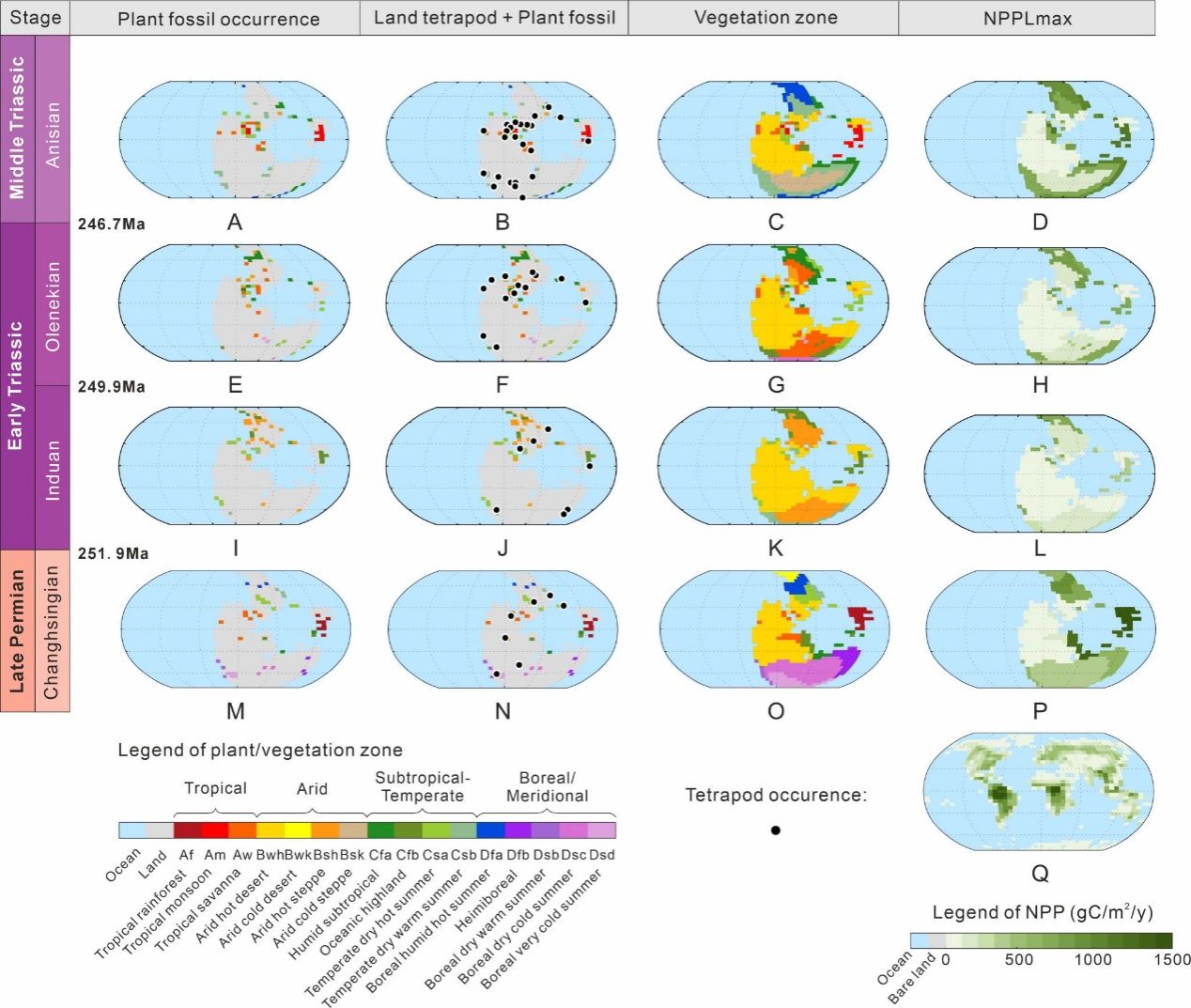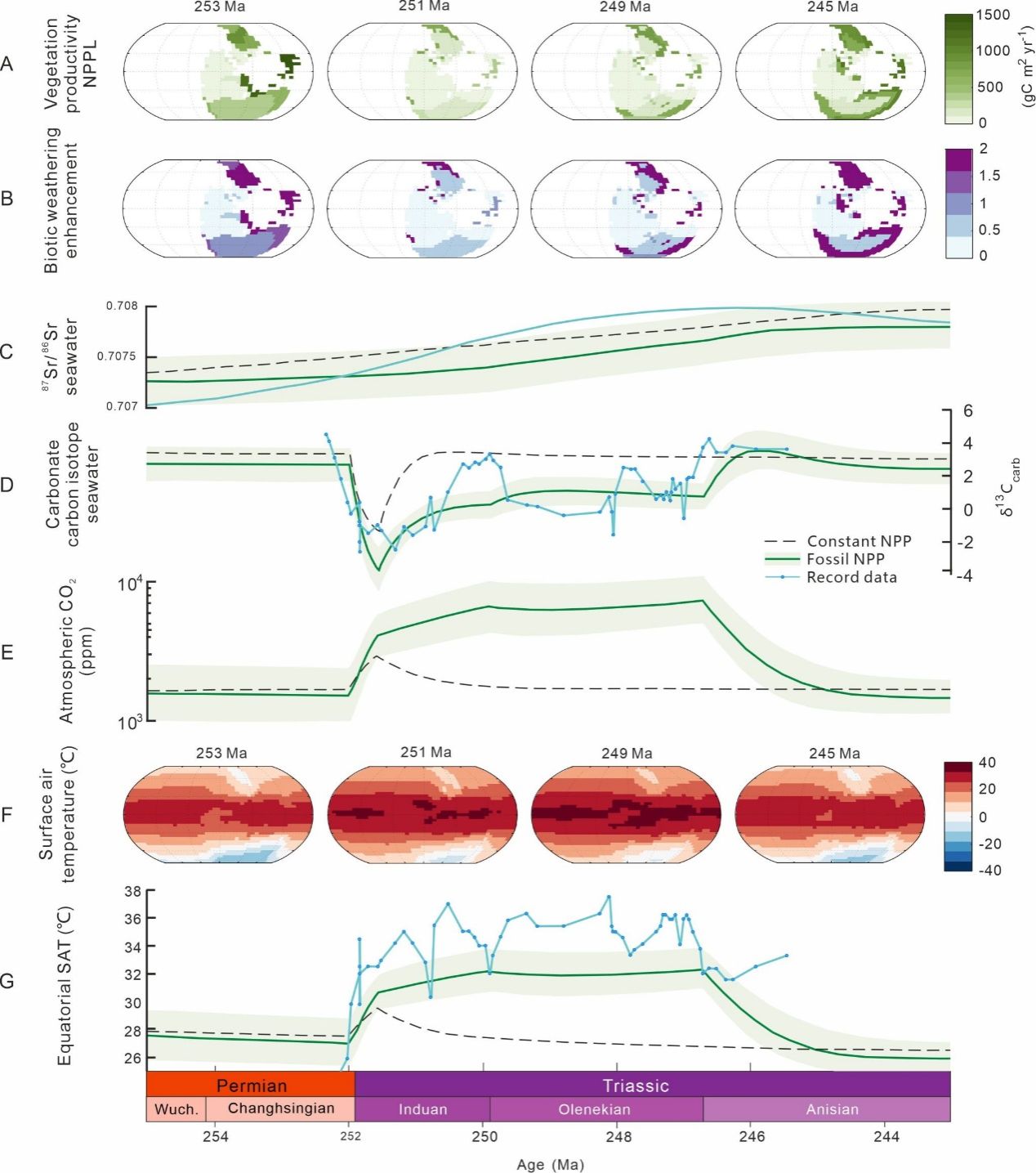Approximately 250 million years ago, the deadliest mass extinction in Earth’s history suddenly erupted. It manifested as the disappearance of around 81–94% of marine invertebrate species and 89% of terrestrial tetrapod genera. This catastrophe is known as the “Permian-Triassic Mass Extinction” (PTME), also called “The Great Dying” (translated as “Earth Life’s Darkest Hour”). Following the extinction, an extreme hothouse climate persisted throughout the 5 million years of the Early Triassic. Why didn’t the Earth “cool down automatically” after the volcanic eruptions? The answer might lie within the plants of the terrestrial ecosystem.
CUG Prof. YU’s Jianxin team led by Academician YIN Hongfu of the Chinese Academy of Sciences, has built a plant fossil database after over twenty years of field fossil collection by three generations of CUG researchers, combined with global literature data. The research team published a paper titled “Early Triassic super-greenhouse climate driven by vegetation collapse” in Nature Communications on July 2, 2025. This achievement was jointly led by CUG and the University of Leeds, involving ten global research institutions.

Fig. 1 Late Permian to Middle Triassic maps of plant and land tetrapod fossil records, vegetation reconstruction and Net Primary Productivity (NPP) distribution.
Based on the database, the research team developed a plant fossil reconstruction and data normalization protocol, conducted sedimentological evidence analysis, and statistically analyzed global land surface rock types and chemical compositions. For the first time, they mapped the spatio-temporal distribution of global terrestrial vegetation and lithological evolution spanning the Permian-Triassic mass extinction to the Middle Triassic recovery stage (Figure 1).

Fig.2 Climate-biogeochemical model driven by terrestrial Net Primary Productivity (NPP) changes.
The team innovatively incorporated plant fossil data into a climate-biogeochemical model, further tracking key element cycling patterns related to plant physiological processes (such as photosynthetic efficiency, root-accelerated weathering, etc.). The research, for the first time, provides a quantitative estimation of changes to global palaeo-plant biomass and corresponding long-term environmental impacts (Figure 2). It clearly pointed out that the terrestrial vegetation loss during the PTME, especially in tropical regions, resulted in an Earth system with low levels of organic carbon sequestration and restricted chemical weathering, resulting in prolonged high CO2 levels.
Plants are nature’s “carbon capturers”, absorbing CO₂ and balancing the carbon budget; the growth and development of plant roots accelerate rock weathering, also consuming CO₂. But when plants disappeared on a large scale, this “ecological air conditioning” system shut down. The massive amounts of CO₂ gas released by volcanic eruptions could no longer be absorbed by terrestrial plants. The Earth fell into a deadly positive feedback loop: fewer forests led to poorer carbon sequestration, higher temperatures made forest survival more difficult, and temperatures continued to rise.
The final results showed that CO2 levels stabilized at around 7000 ppm (modern value 420 ppm), with maximum equatorial surface temperatures of up to 33–34°C (modern value 25-27°C). Heatwaves engulfed the equator, turning Earth into a scorching cage, making it difficult to recover to the pre-extinction state. Only when plants, through long-term evolution, found ways to adapt to the high-temperature environment, and slowly migrated back to the tropics from high-latitude “refuges”, did the ecosystem gradually recover and the climate begin to cool slowly.
The deeper significance of this research is: when vegetation declines below a certain threshold, atmospheric carbon sequestration can suddenly fail. Greenhouse effects will spiral out of control. Even if humans could achieve net-zero carbon emissions at that point, it might be too late – just as temperatures remained high after the Siberian Traps volcanism ceased during the Permian-Triassic period. The Earth would enter a new “steady state”, but organisms that originated and adapted to the previous cooler steady state would struggle to survive, potentially facing extinction.
The frequent occurrence of extreme climate events today is not simply “weather variation”; it may be positively correlated with the reduction of tropical forest area on Earth. The Earth is approaching an ecological tipping point of no return. Using the past to illuminate the present, the research team proposes: forests are not optional; they are the “safeguard” of climate security.
(Edited and translated from the Chinese version)